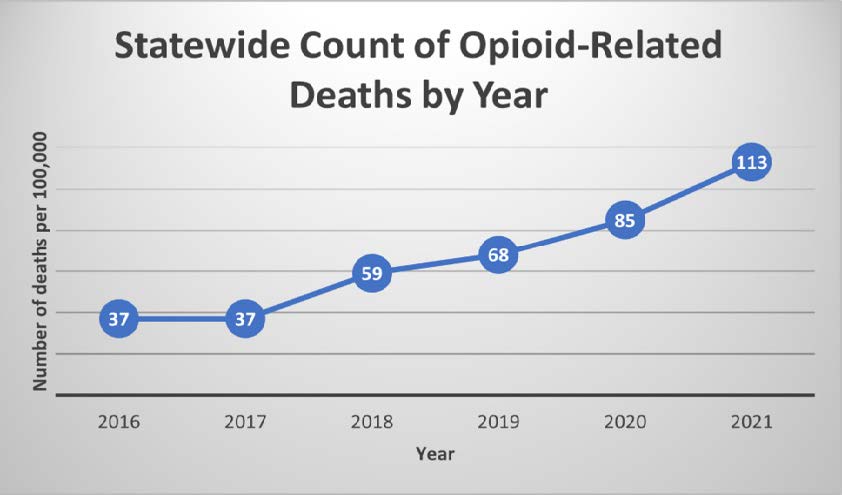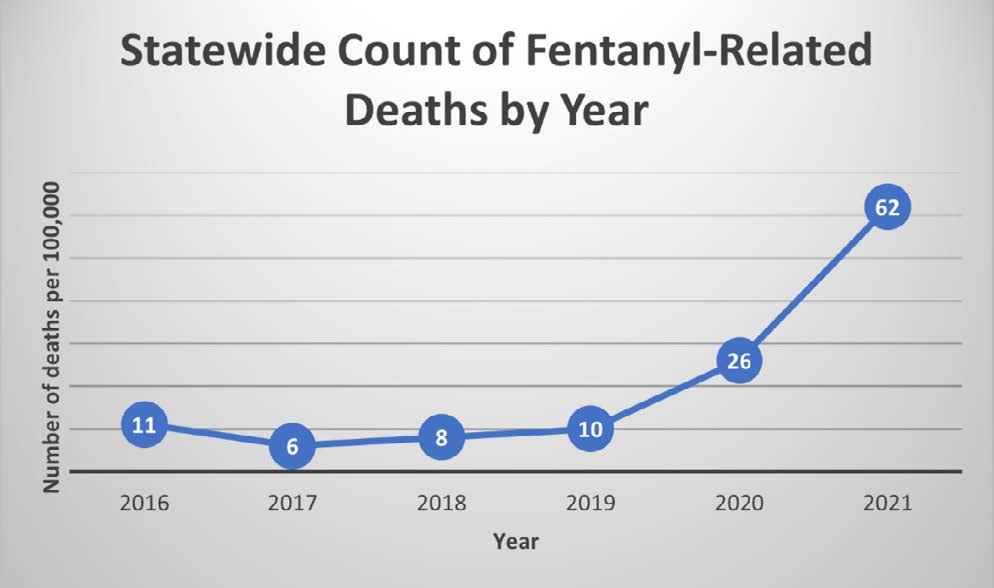Opioid Misuse, Counterfeit Pills and Naloxone: What to Know
In the past 20 years, drug-related overdose deaths have increased by over 500 percent, according to the National Institutes of Health (NIH). The emergence of drugs like fentanyl and xylazine (an animal tranquilizer) are major contributors to the rising death toll. Even in pharmaceutical form, fentanyl is 100 times more powerful than morphine. Depending on a person’s size, just two milligrams of fentanyl can be deadly. Unfortunately, illegal production of fentanyl used without a prescription means users rarely know the concentration being ingested.
Historical data on teen substance use outlines a destructive path. In 2000, the NIH reports the majority of teenage substance use was cigarette and smokeless tobacco, alcohol, and steroids. Use has shifted over 20 years to marijuana, prescription and over-the-counter drugs, and alcohol. Though alcohol remained the most commonly used substance in 2020, UCLA Health found that teenage overdose deaths increased by nearly 50 percent from 2019 and then increased by 20 percent more in 2021. They found the increasing number of teenage deaths was not the result of greater drug use; rather, it can be attributed to drug use becoming more dangerous.
In Montana in 2021, there were 113 opioid overdose deaths. Adults aged 25-44 accounted for 58 percent of deaths, followed by adults aged 45-64 (38 percent); males accounted for 66% overall.

Photo: DEA.gov
WHAT ARE OPIOIDS?
Opioids are a class of drugs that include pain relievers available legally by prescription, the illegal drug heroin, and synthetic opioids such as fentanyl. Opioids act on opioid receptors in both the spinal cord and brain to reduce the intensity of pain-signal perception. Opioids also affect brain areas that control emotion, which can further diminish the effects of painful stimuli.
Prescription opioids are prescribed by doctors to treat moderate to severe pain but can also have serious risks and side effects.
Common prescription opioids include:
- Codeine
- Diphenoxylate (Lomotil®)
- Fentanyl
- Hydrocodone (Vicodin®)
- Methadone
- Morphine (Kadian®, Avinza®)
- Oxycodone (OxyContin®, Percocet®)
- Oxymorphone (Opana®)
WHAT IS OPIOID MISUSE?
Opioid misuse means taking medication in a manner other than prescribed (e.g., taking someone else’s prescription, even if for a legitimate medical complaint such as pain; taking medication to feel euphoria (i.e., to get high) or using illicit opioids such as heroin and fentanyl.
Consequences of opioid misuse include social, economic, and health problems associated with substance use (e.g., illnesses, physical dependence, overdose, crime, car crashes, and suicides related to substance use).
Effects on the body include increased sensitivity to pain, constipation, drowsiness, mental confusion, nausea, vomiting and dry mouth, sleepiness, dizziness, depression, low levels of testosterone that can result in lower sex drive, lower energy and strength, itching and sweating.
Anyone who misuses opioids is at risk of overdosing. It does not matter if the individual is a new or experienced user or if the individual snorts, injects, or takes pills.
WHAT IS FENTANYL?
Fentanyl is a synthetic opioid pain reliever. It is many times more powerful than other opioids and is approved for treating severe pain, typically advanced cancer pain.
In 2021 in Montana, there were 62 fentanyl overdose deaths. Adults aged 25-44 accounted for 73 percent of deaths, followed by adults aged 45-64 (21 percent); males accounted for 71 percent overall.

Photo: DEA.gov
COUNTERFEIT PILLS
A problem is that many illegally-produced pills are counterfeit, and therefore no one can be sure whether they are laced with other drugs, including Fentanyl. These pills look similar to authentic, prescribed medication, and it is often very difficult to tell the difference (Figure 1).
Figure 1. In 2021, the DEA seized over 9.5 million fake pills (DEA.gov). Can you identify which of the pictured pills are from a pharmacy and which are illegally produced? Photo: DEA.gov
Naloxone (Narcan®, Evzio®) is a medication designed to rapidly reverse opioid overdose. It binds to opioid receptors and can reverse and block the effects of other opioids. It can be administered via injection or nasal spray. Naloxone can be purchased without a prescription; it is available at most pharmacies and can be kept at home or carried in case of encountering an emergency.
In Montana, there are online trainings available on how to use Naloxone, dphhs.mt.gov/opioid/.
WHEN TO USE NALOXONE?
Administer Naloxone if it is apparent that someone is experiencing a drug overdose. Some common signs of opioid overdose include:
- Slow, shallowed breathing
- Clammy skin
- Convulsions
- Respiratory depression and arrest (stop breathing)
- Coma
For more information on what opioids are, signs and symptoms of misuse, treatment options, recovery stories and for further educational resources, please visit the following MSU Extension website: montana.edu/extension/health/opioids.html.
Barb Allen is an MSU Extension Associate Specialist.
